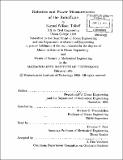Robotics and power measurements of the RoboTuna
Author(s)
Tolkoff, Samuel William, 1973-
DownloadFull printable version (9.615Mb)
Advisor
Michael S. Triantafyllou and Douglas P. Hart.
Terms of use
Metadata
Show full item recordAbstract
The apparatus in the MIT Testing Tank provides a unique opportunity to study both the physics of unsteady flow control and the engineering complexities involved in constraining a vehicle within the geometry of a fish body. The bulk of the work in this study involves clarifying and solving issues with the mechanical and electrical systems of the RoboTuna. We worked toward making the prototype mechanism a robust laboratory instrument, de vising a strong scientific method, reinforcing existing technology and building apparatus to better visualize and quantify the flow field. As existing data for rigid body and ma.Et drag were sparse we conducted a rigorous study of these values. We streamlined the robot, both physically and computationally, revising the data acquisition hardware and software. Confidence in the accuracy of the sensors, and is a suitable calibration routine, is vital to the research. The robot's eighteen internal sensors had not been calibrated since they were installed. We developed an automated calibration routine for the position and load goad sensors, using the motor encoders and supplied torque to classify the built system. Characteristics of the mechanism and sensor performance are now easily, quickly and routinely monitored. Designing and constructing an extensive system for dye visualization and digital particle image velocimetry, we did preliminary work characterizing the boundary layer of the swimming robot. We compare results gathered from the boundary layer of the swimming robot to the law of the wall and real fish swimming. We conducted experimental swimming efficiency runs focusing on the repeatability of the system and its sensitivity to various measurement errors. We have outlined bounds on the validity of our computations and determined how well the RoboTuna is currently performing. As this work represents a piece in a significant ongoing effort, suggestions for future work are included.
Description
Thesis (S.M.)--Massachusetts Institute of Technology, Dept. of Ocean Engineering; and, (S.M.)--Massachusetts Institute of Technology, Dept. of Mechanical Engineering, 1999. Includes bibliographical references (p. 140-143).
Date issued
1999Department
Massachusetts Institute of Technology. Department of Ocean Engineering; Massachusetts Institute of Technology. Department of Mechanical EngineeringPublisher
Massachusetts Institute of Technology
Keywords
Ocean Engineering, Mechanical Engineering